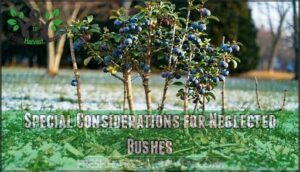This site is supported by our readers. We may earn a commission, at no cost to you, if you purchase through links.
 You’ll get the best results when you prune blueberry bushes during late winter, specifically between February and early March while they’re dormant.
You’ll get the best results when you prune blueberry bushes during late winter, specifically between February and early March while they’re dormant.
This timing hits the sweet spot after harsh winter weather but before buds break open.
Dormant season pruning lets you see the bush’s structure clearly without leaves getting in your way.
You can remove dead wood, shape the plant, and encourage new growth without stressing your bushes or losing this year’s berry harvest.
The key is waiting until temperatures stay consistently above the teens but catching them before any green growth appears, which sets the stage for healthier bushes and bigger harvests with proper timing and pruning.
Table Of Contents
- Key Takeaways
- Blueberry Bush Pruning Basics
- When to Prune Blueberries
- Pruning Techniques and Tools
- Pruning by Bush Age and Type
- Benefits of Regular Pruning
- Frequently Asked Questions (FAQs)
- When should you prune blueberries?
- When is the best time to prune blueberry plants?
- Do you need to prune Rabbiteye blueberry bushes?
- How do you care for a blueberry bush?
- What month do you cut back blueberry bushes?
- What happens if you don’t prune blueberry bushes?
- Are used coffee grounds good for blueberry bushes?
- Do blueberries fruit on new or old wood?
- Can you prune blueberry bushes in summer?
- What happens if you dont prune blueberries?
- Conclusion
Key Takeaways
- You’ll get the best results when you prune blueberry bushes during late winter dormancy, specifically between February and early March, after harsh weather but before buds break open.
- You should focus on removing the 3-4 oldest, thickest canes at ground level each year since blueberries produce their best fruit on one-year-old wood, not older stems.
- You’ll need sharp hand pruners for branches up to ¾ inch and loppers for thicker canes up to 2 inches, making clean cuts at 45-degree angles and disinfecting tools between bushes to prevent disease spread.
- You can expect larger, sweeter berries and healthier plants when you prune regularly, as proper pruning improves air circulation, prevents overcrowding, and redirects energy to fewer, more productive fruiting sites.
Blueberry Bush Pruning Basics
Pruning your blueberry bushes correctly starts with understanding the three main types: highbush varieties that grow 6-8 feet tall, rabbiteye types reaching up to 15 feet, and compact lowbush plants staying under 2 feet.
You’ll get the best fruit production from one-year-old wood, while older stems produce smaller berries, making regular pruning essential for maintaining your bush’s productive capacity.
Fresh growth equals better berries—prune annually to keep your blueberry bushes producing their sweetest, plumpest fruit.
Types of Blueberry Bushes
Understanding types of blueberry bushes is your first step toward successful blueberry pruning.
Each variety has unique characteristics that affect when and how you’ll prune them:
- Highbush Varieties – Most common for home gardens, growing 6-8 feet tall
- Rabbiteye Traits – Heat-tolerant southern favorites reaching up to 15 feet
- Lowbush Cultivation – Wild, compact bushes under 2 feet requiring minimal pruning
Regional adaptations determine bush lifespan and pruning needs.
To improve fruit yields, consider cross-pollination techniques.
Growth Characteristics and Fruit Production
Blueberry bushes produce their best fruit on one-year-old wood, making stem age essential for berry yield.
The secret to prize-winning blueberries lies in understanding which branches produce the sweetest fruit.
Your bush height affects harvest ease, while older stems deliver smaller berries and reduced berry count.
Understanding this growth pattern guides when you prune blueberries for maximum fruit production and quality.
Proper technique involves removing unproductive wood to encourage new growth.
| Bush Type | Height Range | Fruit Production Peak |
|---|---|---|
| Lowbush | Up to 2 feet | 1-year-old wood |
| Highbush | 6-8 feet tall | 1-year-old wood |
| Rabbiteye | Up to 15 feet | 1-year-old wood |
Importance of Pruning for Fruit Yield
Your blueberry bush’s potential lies dormant without proper pruning. Regular pruning blueberries directly impacts yield maximization by removing older, less productive canes that produce smaller berries.
This practice maintains plant vigor, guarantees consistent production, and improves fruit quality. Without annual blueberry bush pruning, you’ll face overcrowded branches that reduce berry size and overall harvest quality substantially.
When to Prune Blueberries
Timing is everything in the context of blueberry bush pruning success. You’ll want to tackle this task during dormancy pruning season, typically from late December through early March.
This window gives you the best shot at maximizing your harvest without stressing your plants. Regional timing matters more than you might think.
Northern gardeners should wait until February or March, while southern growers can start as early as December. The key is pruning after leaf drop but before bud break begins in spring.
Cold damage becomes visible during dormancy, making it easier to spot problem areas that need removal. Your pruning blueberries schedule should align with your local climate patterns and the end of harsh winter weather.
The best time to prune blueberries is when plants are fully dormant but before seasonal growth kicks into high gear. This pruning timing guarantees vigorous spring development and prevents energy loss from active growth interruption. Knowing the right moment to prune also helps align with the ideal harvest times for your blueberry crop.
Pruning Techniques and Tools
You’ll need the right tools to make clean, precise cuts that keep your blueberry bushes healthy and productive.
Sharp hand pruners work best for smaller branches, while loppers handle thicker canes up to two inches in diameter, which is crucial for maintaining healthy bushes.
Hand Pruners and Loppers for Pruning
Sharp hand pruners handle most pruning blueberry bushes tasks, cutting branches up to ¾ inch diameter with their superior cutting capacity.
Loppers provide essential lopper leverage for thicker canes reaching 2 inches, making tough cuts manageable.
Choose ergonomic design pruning tools to reduce hand fatigue during extended sessions.
Consider specialized cutting tools for peak performance.
Quality equipment guarantees clean cuts while proper tool sterilization prevents disease spread between bushes.
Making Clean Cuts and Avoiding Damage
Clean cuts are the backbone of successful pruning blueberries.
Tool sharpness guarantees smooth cuts that heal quickly, while proper cut angles prevent water pooling on stems.
Follow these essential steps when pruning blueberry bushes:
- Keep sharp shears at 45-degree angles
- Cut just above buds for bark protection
- Remove entire branches for stump prevention
- Work steadily for minimizing stress, using sharp shears and making clean cuts to ensure proper cut angles.
Disinfecting Tools to Prevent Disease
Before moving between bushes, sterilization methods like rubbing alcohol or bleach solutions prevent cross-contamination risks that spread plant diseases.
Dip your pruning shears in a 10% bleach solution after removing diseased wood from each bush. This simple tool maintenance step stops soilborne diseases from hitchhiking on your equipment.
Proper sanitation requires a suitable shear disinfectant for effective use. Solution effectiveness depends on proper contact time and concentration for reliable disease prevention.
Pruning by Bush Age and Type
Your blueberry bush’s age and variety determine exactly how you’ll approach pruning, since young plants need gentle training while mature bushes require aggressive renewal cuts.
Different blueberry types, from towering rabbiteye varieties to compact lowbush plants, each demand specific pruning strategies to maximize their fruit production potential.
Pruning Young Blueberry Bushes
Young blueberry bushes need gentle first-year pruning focused on establishing strong foundations.
Remove all flower buds during the initial three years to prioritize root development over fruit production.
Select the healthiest canes while eliminating weak, crossing, or diseased growth.
This encouraging growth strategy builds robust plant structure.
Light winter pruning helps young blueberries develop proper framework for future harvests.
Pruning Established Blueberry Bushes
Established blueberry bushes need annual pruning during dormancy to maintain peak performance.
You’ll want to focus on cane removal and crown thinning for maximum light penetration and bush vigor.
Proper pruning also improves airflow, reducing fungal diseases and improving overall plant health.
Consider seasonal pruning practices for superior results.
Essential steps for pruning mature blueberries:
- Remove 3-4 oldest canes – Cut the thickest, woodiest stems at ground level to encourage fresh growth
- Thin crossing branches – Eliminate canes rubbing against each other to improve airflow and fruit quality
- Clear dead wood – Strip away diseased or damaged growth that steals energy from productive canes
Special Considerations for Neglected Bushes
Neglected bushes need serious renewal pruning for plant resurrection.
Cut all canes to ground level during dormancy for complete bush revival. This severe pruning shocks inherited plants but stimulates vigorous growth.
Add soil amendments around the base after cane removal. Patience required—expect minimal fruit the first year but dramatically improved harvests in year two.
Benefits of Regular Pruning
When you prune your blueberry bushes regularly, you’ll get larger, better-quality berries and healthier plants that produce fruit year after year.
Proper pruning removes old wood, improves air circulation, and prevents diseases while encouraging new growth that produces the best fruit, which leads to healthier plants.
Improving Fruit Quality and Yield
Regular pruning directly impacts berry size and fruit sweetness by redirecting energy to fewer, healthier fruiting sites.
You’ll notice bigger berries when overcrowded branches are removed, allowing remaining fruit to develop fully.
Pruning for fruit production maximizes yield by encouraging vigorous one-year-old wood that produces the sweetest berries.
This focused energy creates better berries with enhanced size and superior flavor quality.
Enhancing Bush Structure and Air Circulation
Proper pruning techniques blueberries create an open canopy that transforms your bush’s health.
Strategic cane removal eliminates overcrowded branches, allowing sunlight penetration throughout the plant. This improved air circulation prevents moisture buildup while promoting uniform growth patterns.
An uncongested center gives each branch room to flourish, creating stronger bush structure that supports heavier fruit loads.
Effective pruning also requires understanding fruit tree pruning techniques to maximize plant potential.
Preventing Disease and Promoting Healthy Growth
Through strategic cane removal, you’ll create airflow benefits that transform your blueberry bush into a disease-fighting fortress.
Better air circulation and light penetration work together for effective disease management during each growth cycle.
Your pruning benefits include:
- Sunlight exposure reaches interior branches
- Disease prevention through improved ventilation
- Plant health improvement via dead wood removal
- Enhanced air circulation reduces fungal problems
Frequently Asked Questions (FAQs)
When should you prune blueberries?
Like a hibernating bear, your blueberry bushes rest during winter’s dormancy.
You’ll want to prune them between December and March, after leaf drop but before buds swell, ensuring vigorous spring growth and abundant fruit production.
When is the best time to prune blueberry plants?
You’ll want to prune your blueberry plants during dormancy, typically late February through early March.
This timing allows you to remove winter damage while promoting vigorous spring growth for better fruit production.
Do you need to prune Rabbiteye blueberry bushes?
Yes, you’ll need to prune rabbiteye blueberry bushes annually during dormancy. These vigorous growers can reach 15 feet tall, so regular pruning keeps them manageable and productive by removing old canes.
How do you care for a blueberry bush?
You’ll need acidic soil with pH 5-5, consistent moisture, and annual dormant-season pruning.
Feed with acid-loving fertilizer, mulch around the base, and make certain good drainage for healthy growth and abundant fruit production.
What month do you cut back blueberry bushes?
Winter’s icy grip signals the perfect pruning window.
Cut back your blueberry bushes during February or March while they’re dormant.
This timing guarantees vigorous spring growth and prevents stress from active growing phases, ensuring a healthy start for your blueberry bushes with dormant periods.
What happens if you don’t prune blueberry bushes?
Your blueberry bushes will become overcrowded and produce smaller, fewer berries if you skip pruning.
Old canes dominate, blocking sunlight and airflow, which reduces fruit quality and substantially increases disease risk.
Are used coffee grounds good for blueberry bushes?
Like finding treasure in your kitchen, coffee grounds make excellent acidic fertilizer for your blueberry bushes.
They’ll lower soil pH, add nitrogen, and improve drainage—exactly what these acid-loving plants crave for ideal growth.
Do blueberries fruit on new or old wood?
Blueberries produce their best fruit on one-year-old wood, specifically on two-year-old twigs.
You’ll get the biggest harvest from branches that developed last season, while older canes produce smaller, fewer berries over time.
Can you prune blueberry bushes in summer?
Timing’s everything in the context of pruning—you shouldn’t prune blueberry bushes in summer.
Summer pruning removes next year’s fruit buds and stresses plants during active growth, reducing your harvest substantially.
What happens if you dont prune blueberries?
Without annual pruning, your bushes will overproduce one year then skip the next, creating smaller berries on overcrowded branches.
You’ll face harder harvesting, poor air circulation, increased disease risk, and declining fruit quality over time, including poor air circulation.
Conclusion
Ready to transform your blueberry harvest from disappointing to abundant?
Timing your pruning correctly makes all the difference between struggling bushes and productive plants.
When you prune blueberry bushes during late winter dormancy, you set the foundation for healthier growth and larger yields.
Follow proper techniques, use clean tools, and match your approach to bush age.
With consistent annual pruning, you’ll enjoy sweeter berries, stronger plants, and harvests that make your gardening efforts worthwhile for years ahead, resulting in a truly abundant harvest.
- https://news.oregonstate.edu/news/prune-blueberries-yearly-more-fruit
- https://www.uvm.edu/vtvegandberry/factsheets/pruningblueberries.html
- https://www.reddit.com/r/gardening/comments/1chb24d/when_and_how_to_prune_our_blueberry_plant
- https://www.thompson-morgan.com/pruning/blueberries
- https://growingsmallfarms.ces.ncsu.edu/2025/01/prune-blueberries











